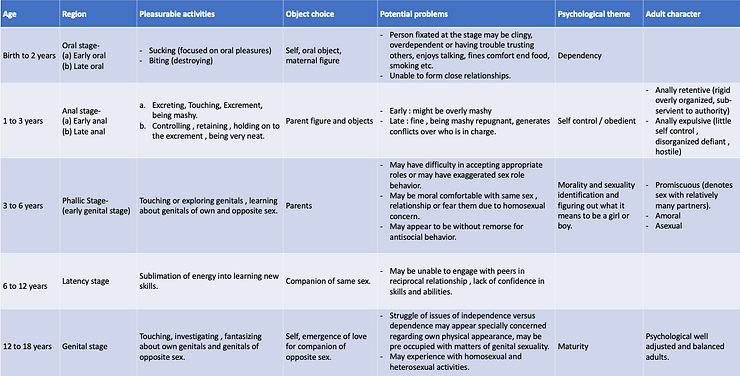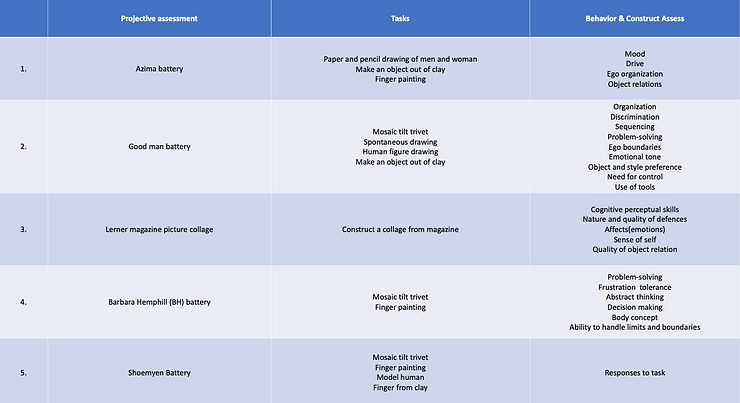Definition
A psychodynamic explains how mental processes, such as perception, thoughts, and feelings that are conscious and unconscious, influence the choice of participation in and satisfaction with an occupation.
Theoretical base
It is based on Freud’s psychoanalytic theories. The three major areas of concern are the psychodynamic states of psychosexual and psychosocial development, as well as the process by which the content of intro psychology is altered.
Assumptions-
-
Intrapsychic content is the major factor that influences our behaviour.
-
Intrapsychic content can be best altered by bringing it to a point where it can be examined and evaluated in the context of a shared reality.
-
Repeat it in interactions and situations that elicit intrapsychic conflict with adequate guidance to facilitate conflict resolution and the addition of new, more adaptive intrapsychic content.
-
The sum of an individual’s intrapsychic content is thought to be heavily influenced by their life experiences. How a person thinks and feels about himself and others is believed to be a result of past interactions with others.
-
Lack of skills in various areas of human function is considered to be a sign of maladaptive or conflicting intrapsychic content. It is regarded as a sign of dysfunctional behaviour.
ID-
-
That portion of the mind and psyche (internal thought) that is unable to differentiate between fantasy and that wants immediate gratification is said to revise a portion of the self that Freud called the ID.
-
The ID is used for birth and other issues, including survival.
-
When biological needs are not met, it experiences tolerable tension and pleasure when needs are met and tension is released.
-
However, the ID is not capable of logical thinking.
Ego-
-
The ego strives to satisfy with pleasure but it can realistically assess the outside world.
-
According to Freud, ego functions assist an individual with the task of becoming aware of stimuli by storing experiences with them in memory, avoiding excessive extreme stimuli through thought flight, and learning about changes in the external world to their advantage.
Topographical model of the mind-
Freud divided the mind for three reasons:
-
The conscious system-It is the part of the mind where perception comes from the outside or from within the body and mind, or where perception is brought into awareness.
-
The preconscious system-it is made up of mental events, processes, and thoughts that can be brought into conscious awareness by focusing attention, and it serves to maintain repression and contrast unacceptable wishes and desires.
-
Unconscious system-dynamic and its mental content, as well as processing our minds from conscious awareness via control or repression.
-
It is closely related to a desire to have content that is limited to wishes and seeking fulfilment.
-
These wishes motivate dreams and neurotic formation.
Relation between ego function and task choice –
-
Those mental disorders in which the ability of the ego to do its job is severely impaired are identified as psychosis.
-
Knowing that a client is exhibiting behaviour is a signal for the therapist to pay special attention to specific issues, structure the task environment and reduce the demands for decision making by the individual.
-
In principle, the more impaired the ego, the less the individual makes sound judgements and can control his or her behaviour.
-
Stress, physical illness, mental illness, fatigue and the use of alcohol and other drugs can all influence ego function.
-
The ego enables adaptation and participation in a purposeful occupation.
Super Ego –
-
The ego is guided by logic rather than normal imperatives because a child’s survival is initially dependent on the love and approval of its parents.
-
The child of love is what is commonly called conscience, and inner voice that influences actions by evoking guilt when he or she is displaced by others and pride when he or she has done what is perceived as right or approved of.
-
This occurs in the area of the psyche that Freud called the superego.
Psychological stages of psychosocial development –

Function – dysfunction continuum–
-
Sometimes they are not well-defined and they are frequently not manually exclusive.
-
Intrapsychic content comes in neat little packages. It tends to be interrelated, locked up in an apparent order and without firm boundaries.
-
Continuum’s main focus on –
(a) Conflicts are believed to be typical of various states of development.
(b) Conflict areas are related to developing mental states such as love, hate, aggression, sexuality, autonomy, trust and death and loss.
(c) Maladaptive, intrapsychic content such as accurate ideas about oneself and other people.
Behaviour indicating dysfunction –
-
Any behaviour that can not be explained by abandoning the reality of the situation and/or any behaviour that causes the individual to be at ease with themselves or with others.
-
The link between disordered behaviour and the nature of an individual’s dysfunctional, intrapsychic content is made through the use of a system of psychodynamics.
Postulates regarding change –
-
It is less specific in an analytical FOR than in the other FORs. One of the major reasons for this is that the change process tends to be cyclical in nature. With a lot of repetition of sharing, making associations, interpretations, the development of Incyte and working through it.
-
It also tends to be vague regarding setting up goals. No guidelines for sequential goals are usually provided.
-
Identifying progress and a time for the end of the change process tends to be somewhat subjective. It is frequently based on how the client feels about him or herself and on the degree of environmental and environmental interactions.
-
The use of analytical FOR is appropriate with clients who show evidence of intrapsychic conflict or maladaptive intrapsychic content because of past faulty experience in interactions in the environment or with clients who have experienced a marked alteration in their life situations.
-
Participation in a change process based on an analytical FOR requires a fairly high degree of cognitive function, verbal skills and psychological sophistication.
Treatment –
(A). Universal issues –
-
Universal issues are those themes, concerns or matters or substances that are an intrinsic part of being human. They are a reality, trust, intimacy, adequacy, dependence/independence, sexuality, aggression and loss.
-
Re-conciliation of universal issues involves an alteration of the intrapsychic content.
-
Following such a change in the individual, they should alter their behaviour and attempt to manipulate the environment.
-
Based on this, the goal of intervention is to assist the individual and reconcile those universal issues that are a legitimate concern.
-
Its use is appropriate for individuals who are unable to reconcile universal issues because of maladaptive intrapsychic content that has resulted from faulty life experiences.
-
Poorly reconciled and unreconciled universal issues tend to maladaptive behaviour and the experience of severe discomfort.
(B). Re-conciliation of universal issues –
-
Universal issues are only reconciled; they are never resolved, and they are always furrowed.
-
Reconciled is used in the sense of bringing them into agreement and harmony, making them compatible and consistent.
-
Reconcile a person’s thoughts and feelings about universal issues and the objective state of the environment.
Evaluation –

Defence Mechanism
Unconscious strategies are used to avoid anxiety, resolve conflict and enhance self-esteem. According to Freud, these are the mechanisms which the ego develops to help deal with ‘ID’ and the ‘superego’. These tend to distort, transform or otherwise falsify reality.
Types-
1.Narcissistic
I) Denyl
This is the process by which an individual protects himself against painful information by refusing to accept its validity.
Example – when a person who on first hearing that a loved one has refused to believe it.
II) Distortion
External reality is being radically reshaped to meet your needs.
III) Projection
This is a process in which a person expresses gratitude to another person for a feeling he is experiencing.
2.Immature
i) Regression
This is a process by which an individual reverts to a more infantile way of meeting his needs. This is a movement back to a psychological time when one is faced with stress.
For example, going to school for the first time at the age of five may result in a toilet accident.
II) Acting Out
III) Blocking
IV) Hypochondriasis ( Conversion reaction)
This is a process by which unconscious wishes or thoughts are repressed, then challenged and make their appearance via a variety of physical or somatic symptoms.
V) Introjection
VI) Passive Aggression
VII) Somatization
3.Neurotic
I) Displacement
Satisfying an impulse (aggression) with a substitute object.
For example, a person who is engaged with his boss but cannot express his feelings for fear of being fired may come home and scream at his children.
II) Intellectualisation
A nurse, for example, may describe a dying patient intellectually.
III) Rationalisation
This is a process in which an individual makes excuses for himself or justifies his own, or someone else’s, unacceptable behaviour.
When a person dies, for example, they may overreact and then rationalize by believing that it was a bad day.
IV) Repression
Expelling or regaining consciousness, ideas, or feelings.
V) Reaction formation
Changing an unfavourable impulse into its polar opposite.
VI) Externalisation
VII) Inhibition
VIII) Isolation
IX) Disassociation
X) Controlling
XI) Sexualization
4.Mature
I) Altruism
Using constructive and instinctually gratifying service to others.
II) Anticipation
Anticipating or making plans for the future is unpleasant.
III) Asceticism
Eliminating the pleasurable effects of experience.
IV) Humour
Using comedy to overtly show feelings and thoughts without producing an unpleasant effect on others.
V) Sublimation
Instead of being blocked or diverted, it allows an instinct to be changed. Satisfying an impulse with a substitute object.
Exemplification: Participate in sports.
VI) Suppression
Consciously or semi-consciously, postpone attention to a conscious impulse or a conflict.



